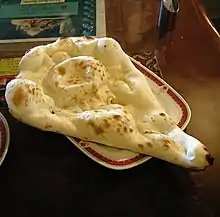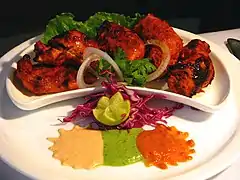.jpg.webp) Puttu | |
| Course | Breakfast |
|---|---|
| Place of origin | India |
| Region or state | Kerala Tamil Nadu |
| Main ingredients | Rice flour, coconut, salt |
Puttu (Malayalam: പുട്ട്; Tamil: புட்டு; (pronounced [ˈputtu]), also called pittu Sinhala: පිට්ටු) is a dish native to the Southern Indian state of Kerala, Tamil Nadu, parts of Karnataka, and Sri Lanka. Puttu means "portioned" in Tamil and Malayalam. It is made of steamed cylinders of ground rice layered with coconut shavings, sometimes with a sweet or savory filling on the inside. Puttu is usually a breakfast dish served hot with either sweet side dishes such as palm sugar or banana, or savoury with chana masala, chutney, rasam, or meat curries.
Ingredients

Puttu principally consists of coarsely ground rice, grated coconut, little salt and water. It is often spiced with cumin, but may have other spices. The Sri Lankan variant is usually made with wheat flour or red rice flour without cumin, whereas the Bhatkal recipes have plain coconut or masala variant made with mutton- or shrimp-flavoured grated coconut.
In Bangladesh, the outside is made of a mixture of rice flour and ground moong dal, while the filling is a mixture of coconut flakes and a type of caramelized sugar that is similar to dulce de leche.[1]
Preparation

Puttu is made by slowly adding water to ground rice until the correct texture is achieved. Using hot water would improve the softness of puttu. It is then spiced, formed and steamed with layers of grated coconut.[2]
Puttu is generally cooked in an aluminium puttu kutti[3] vessel with two sections. The lower section holds water and the upper section holds the puttu, where the rice mixture is inserted with layers of grated coconut. Perforated lids separate the sections to allow the steam to pass between them.
A number of alternative cooking vessels are used, such as traditional vessels where a perforated coconut shell is attached to a section of bamboo, or a chiratta puttu made of a coconut shell or of metal shaped similarly to a coconut shell.

Other types of cooking vessels include a pan similar to an idli pan with small holes in the bottom, and pressure cookers.
Serving
Puttu is often served along with gravies, like fish curry, chicken curry, beef curry or kadala (chickpea) curry, and papadum. Also plantain, jackfruit, mango or banana is commonly served with it. In southern Kerala people eat puttu accompanied by sweet black coffee.
In Tamil Nadu it is served with grated coconut with jaggery made of palm sugar or sugar cane, or with sweetened coconut milk.
In Sri Lanka, pittu is usually accompanied with tripe curry, fish or a meat curry, coconut milk and a sambol.
In Kerala, puttu is served with banana or plantain, kadala curry, payar (green lentils) thoran with papad, fish or meat curry.
There are also many improvisations and experiments done on puttu in Kerala. Wheat and maize flours are used instead of rice in certain parts. There are also puttu-specialised restaurants that serve it with different fillings.[4]
Variations

.jpg.webp)
Some variations of puttu use other grains such as wheat flour, ragi (finger millet) flour, tapioca and corn flour. The layered filling of coconut can be replaced by other foods, such as egg curry or banana. Puttu prepared in a ball shape are called manipputtu. Puttu can also be made using bamboo rice.
Muslims in Kerala eat a version of puttu called irachiputti in which rice is layered with spiced mincemeat.[5]
Puttu is also very common in Mauritius. It is usually sold by hawkers and is served as a snack. It is often misspelled poutou, and should be spelled putu in Mauritian Creole.[6] The ingredients are the same—rice flour, sugar and desiccated coconut, but cooked in metal cylinders.
In Hindu mythology
In Tamil Nadu, puttu is mentioned in a common legend and related festival involving Shiva. This legend, known as the puttuku mann sumantha leelai (translated from Tamil as "the divine game of moving sand in exchange for puttu"), retells how, following a flood of the Vaigai River, King Arimarthana Pandian ordered his subjects to carry sand to plug breaches in the river bank. An aged woman named Vanthiammai is said to have been unable to carry out this duty, whereupon Shiva is said to have appeared in the guise of a manual laborer named Chokkan and offered to move the sand in her stead in exchange for puttu, which would serve as his wage. After eating the puttu, Chokkan instead fell asleep on the river bank. Seeing this, the king became enraged and struck him with a cane. It is claimed that instead of harming Chokkan, the cane blow was felt by all bystanders, including the king himself. Chokkan subsequently reveals his true form as Lord Shiva, grants Vanthiammai moksha, and causes the floods to recede. This myth is re-enacted yearly during the puttu thiruvizha portion of the Avani Moola festival at the Meenakshi Sundareswarar Temple in the Puttuthoppu region of Arappalayam, a neighborhood of Madurai. Puttu is commonly sold and distributed at the festival.[7][8][9]
World record attempt
In 2006, students of the Oriental school of Hotel Management in Wayanad in north Kerala made a 10-foot-long puttu. They cooked the giant puttu in a specially designed 12-foot-long aluminum mould, using 20 coconuts and 26 kg of powdered rice. It took about one and a half hours to cook.[10]
Similar dishes
In Maritime Southeast Asia, there are numerous similar dessert dishes known as kue putu in Indonesian, putu piring in Singapore and puto bumbong in Tagalog. They vary by preparation and ingredients but are also steamed in bamboo tubes and are served with sugar and grated coconut.[11][12]
In Indonesia, kue putu is characteristically green due to the use of pandan flavoring. It is commonly found being sold by traveling vendor carts together with klepon, which is actually ball-shaped kue putu.[11]
In the Philippines, puto bumbong is deep purple in color due to the use of a unique rice variety called pirurutong. They are culturally significant as a common traditional Christmas dessert.[13] Puto in the Philippines is also a general term for traditional steamed rice cakes.
See also
References
- ↑ "BBC Indian Food Made Easy: Recipe for puttu", BBC, archived from the original on 24 December 2008, retrieved 13 August 2010
- ↑ Nair (Life), Rajeev. "'Puttu'ing plan B in place". Khaleej Times. Retrieved 20 November 2020.
- ↑ "'Puttu' ing it: Kicha from Kochi in 'The Ellen DeGeneres Show'". OnManorama. Retrieved 20 November 2020.
- ↑ Nagarajan, Saraswathy (19 November 2020). "This Kerala joint serves puttu to suit your political inclinations". The Hindu. ISSN 0971-751X. Retrieved 21 April 2021.
- ↑ Brien, Charmaine O' (2013). The Penguin Food Guide to India. Penguin UK. ISBN 978-93-5118-575-8.
- ↑ "Lalit". www.lalitmauritius.org.
- ↑ "Hundreds witness 'Puttu tiruvizha'". The Hindu. 26 August 2015. ISSN 0971-751X. Retrieved 13 April 2023.
- ↑ "Tale of yore re-enacted at Meenakshi temple". The Times of India. 12 September 2016. ISSN 0971-8257. Retrieved 13 April 2023.
- ↑ "Divine episode enacted on Vaigai bank". The Hindu. 6 September 2022. ISSN 0971-751X. Retrieved 13 April 2023.
- ↑ "Kerala's Hotel Management Students Cook Up World Record Puttu", Indiatourism, retrieved 22 October 2010
- 1 2 Anggara Mahendra (13 June 2013). "'Kue Putu' Steamed Green Cake". Baily Daily. Archived from the original on 15 June 2015. Retrieved 12 June 2015.
- ↑ Angelita M. del Mundo (1995). "Emerging Versions of Some Traditional Philippine Rice Food Products". In Harlan Walker (ed.). Disappearing Foods: Studies in Food and Dishes at Risk. Proceedings of the Oxford Symposium on Food and Cookery 1994. Prospect Books. p. 64. ISBN 9780907325628.
- ↑ Sastrillo, Berna (29 November 2017). "The Search for the Best Puto Bumbong in Manila". ModernFilipina. Retrieved 5 December 2018.


